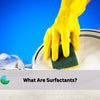How to Clean and Wash a Leather Jacket
- by Brodie Cook

Leather jackets are a popular choice for fashion and keeping warm. They look great and can last a long time if you take good care of them. However, leather is a delicate material that needs special attention when cleaning. You can't just throw a leather jacket in the washing machine like you would with other clothes.
In this article, we'll show you how to safely clean your leather jacket at home. We'll cover the basic steps for getting rid of dirt and stains, as well as some tips for dealing with tougher marks. By following these simple instructions, you can keep your leather jacket looking like new for years to come.
Cleaning Your Leather Jacket: The Basics
For most dirt and light stains, you can clean your jacket at home using a few simple tools and techniques. Here's what you'll need:
- A soft cloth or brush
- Laundry Detergent Sheet
- A bowl of clean, warm water
- A clean, dry towel
- Leather conditioner
To clean your leather jacket, start by checking the care label for any specific instructions from the manufacturer. If there are no instructions or you're unsure, test your cleaning method on a small, hidden area first to make sure it won't damage the leather. Once you're ready to clean the whole jacket, follow these simple steps:
- Use a soft cloth or brush to gently remove any dust or dirt from the surface of the jacket.
- Mix half a sheet of detergent with warm water to create a cleaning solution.
- Dip a soft cloth or sponge into the soap solution, wring it out so it's damp but not soaking wet, and gently clean the jacket using light circular motions.
- Use a second cloth dipped in clean water to wipe away any remaining soap residue.
- Dry the jacket by gently patting it with a clean towel, then hang it in a cool, well-ventilated area to air dry completely. Avoid using direct heat sources like hairdryers or radiators, as they can dry out and cause damage to the leather.
- Finally, apply a small amount of leather conditioner to keep the leather soft and supple.
How to Remove Stains from a Leather Jacket?

Sometimes, your leather jacket may get tougher stains that won't come out with just mild soap and water. Don't worry, though - there are a few household items you can use to tackle these stains without damaging your jacket.
For food stains, start by blotting away any excess with a clean cloth. Then, gently clean the area with a damp cloth. If the stain remains, you can try using a mixture of equal parts water and white vinegar.
Grease stains can be tricky, but you can try sprinkling some cornstarch or baking powder on the stain and letting it sit overnight. In the morning, brush away the powder and wipe the area with a damp cloth.
For ink stains, dip a cotton swab in some nail polish remover or rubbing alcohol and gently dab the patch. Be sure to test this method on a small, hidden area of the jacket first, as some leathers may discolor.
If your jacket develops mold or mildew, mix equal parts water and rubbing alcohol and wipe the affected area with a clean cloth. Be sure to let the jacket dry completely before wearing it again.
For oil stains, sprinkle some baking soda, baby powder, or cornstarch on the stain. Let it sit for a few minutes to absorb the oil, then gently rub the powder into the stain with a damp cloth. Brush away the powder and repeat if necessary.
Deep Cleaning the Lining (for washable linings only)
If your leather jacket has a removable lining, you may be able to wash it separately for a deeper clean. However, it's important to check the care label first to make sure the lining is actually washable. Some linings may be made of delicate materials that can be easily damaged by washing.
If the care label says the lining is washable, you can follow these steps to clean it:
- Remove the lining from the jacket according to the manufacturer's instructions.
- Fill a sink or basin with cool water and add a small amount of mild detergent. Swish the water to mix in the detergent and create suds.
- Submerge the lining in the soapy water and gently agitate it with your hands. Be sure to pay extra attention to areas that tend to get dirty, like the collar and cuffs.
- Drain the soapy water and rinse the lining thoroughly with clean water until all the soap is removed.
- Gently squeeze out the excess water (don't wring or twist the lining) and hang it up to air dry. Avoid using a clothes dryer, as the heat can damage the fabric.
Once the lining is completely dry, you can reattach it to the jacket according to the manufacturer's instructions.
Conditioning the Leather Coat
After cleaning your leather coat, it's important to condition the leather to keep it soft, supple, and protected from damage. Leather conditioner helps to replenish the natural oils in the leather that can be stripped away by cleaning or everyday wear.
To condition your jacket, start by applying a small amount of leather conditioner to a clean, soft cloth. Gently rub the conditioner into the leather and always use circular motions, covering the entire surface of the jacket. Be sure to pay extra attention to areas that may be more prone to drying out, like the elbows and shoulders.
After applying the conditioner, let the jacket sit for a few minutes to allow the conditioner to absorb into the leather. Then, use a clean cloth to buff the jacket and remove any excess conditioner. Your jacket should now be clean, soft, and ready to wear!
How to Care for Your Leather Jacket to Maintain its Quality?
Taking good care of your leather jacket doesn't stop at cleaning and conditioning. There are a few extra things you can do to keep your jacket looking its best for years to come.
When you're not wearing your jacket, it's important to store it properly to prevent damage. Here are a few tips:
- Store your jacket in a cool, dry place away from direct sunlight. A closet or garment bag works well.
- Use a sturdy, padded hanger to maintain the jacket's shape. Avoid using wire hangers, as they can stretch out the shoulders.
- If you plan to store your jacket for a long time, consider using a leather protector spray to repel water and prevent stains.
Be careful when wearing your jacket, too. Avoid applying hairspray, perfume, or pins directly to the leather, as these can cause damage or staining. If you do get a stain on your jacket, try to clean it as soon as possible using the methods we discussed earlier.
Finally, if your jacket has a delicate lining or a particularly tough stain, it may be best to take it to a professional leather cleaner. They have the expertise and tools to clean your jacket safely and effectively.
Conclusion
Cleaning and maintaining your leather jacket may seem tough, but with the right tools and techniques, it's easy. Follow the steps in this guide to keep your jacket looking great for years.
Always check the care label first, and test cleaning methods on a small area. Use mild soaps and cleaners, and avoid too much water or heat. If unsure, take your jacket to a professional leather cleaner. With some care, your leather jacket will stay a stylish and timeless part of your wardrobe.
FAQs About How to Wash a Leather Jacket
Can I wash my leather jacket in a washing machine?
No, you should not wash your leather jacket in a washing machine. The agitation and water can damage the leather, causing it to lose its shape and finish. Instead, spot clean with a damp cloth and mild soap, or take it to a professional leather cleaner to keep it in good condition.
My leather jacket is looking a little worn out. Any suggestions to freshen it up?
To freshen up a worn-out leather jacket, start by gently cleaning it with a damp cloth and mild soap. Apply a leather conditioner to restore moisture and shine. For deeper scratches or scuffs, use a leather repair kit. Finally, let it air out to remove any odors. If needed, take it to a professional leather cleaner.
Is it safe to put a leather jacket in the dryer?
No, it is not safe to put a leather jacket in the dryer. The heat can cause the leather to shrink, crack, or become misshapen. Instead, air dry your leather jacket by laying it flat on a towel or hanging it in a well-ventilated area, away from direct sunlight or heat sources.

 Dishwashing
Dishwashing Laundry
Laundry Bundles
Bundles Toilet
Toilet



